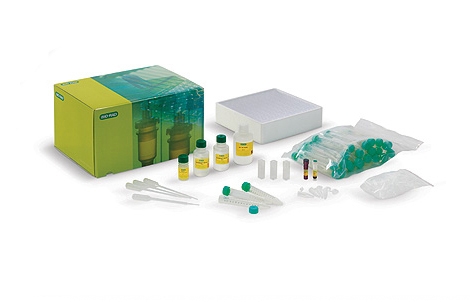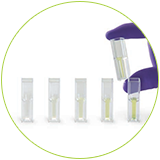
Description
Description
Enzyme Lab Activity for AP Biology and Biotechnology Classrooms
The Biofuel Enzyme Reactions Kit for AP Biology is a student-driven, inquiry-based kit that characterizes the activity of the cellobiase enzyme. In this ThINQ! Investigation, students will play the role of bioengineer to explore the power of enzyme kinetics and optimize conditions that will maximize the rate of sugar conversion for the production of biofuel.
Features and Benefits
- Aligns with AP Biology Big Ideas 2 and 4
- Introduction to enzyme kinetics with real world application to biofuel energy
- Enables both qualitative and quantitative measurements of reactions
- Contains no caustic reagents
Classroom Experience
Students first extract cellobiase from mushrooms to discover one way that nature uses enzymes. They then generate questions and hypotheses about enzyme function under different environmental conditions — temperature, pH, and concentrations — that influence enzyme function. Students can take a structured, guided, or open approach to inquiry as they test their hypotheses. Finally, with data in hand, students use evidence to create a list of conditions for optimal enzymatic activity for biofuel production.
Timeline and Contents Overview
The flexible curriculum will fit within a broad range of available laboratory times. A possible arrangement is:
- Day 1: Pre-lab activity and background review
- Day 2: Investigation 1
- Day 3: Investigations 2–5 (divided into groups)
- Day 4: Investigation 6 and post-lab assessment
- Day 5: Science Case Study
Background Information
Cellulosic ethanol is a biofuel derived from plant matter. Cellulose is a polysaccharide found in the cell walls of plants; and cellobiose is a disaccharide constituent of cellulose. The breakdown of cellulose into smaller sugars is a multistep process that is facilitated by a family of enzymes called cellulases. Each cellulase has its own role in processing cellulose from a long strand of glucoses down to single units that can then undergo microbial fermentation to produce ethanol.
A key step in the production of cellulosic ethanol is the breakdown of cellobiose by the cellobiase enzyme. Students test and calculate the conversion rate of a sugar substrate (p–nitrophenyl glucopyranoside) to p–nitrophenol and glucose in the presence or absence of cellobiase.
Select the kit which is right for you and your students:
|
|
ThINQ! Biofuel Kit |
Classic Biofuel Kit |
|
Standards alignment |
AP Biology |
General Biology, Biotechnology, CTE |
|
Pedagogical support |
Open, guided, and structured inquiry |
Structured inquiry |
|
Main learning objectives |
Focus on student-driven questions and problem solving |
Mastery of technical skills |
|
Initial experiment |
Compare reaction rates of mushroom extracts Focuses on inquiry process |
Compare reaction rates with and without purified enzyme Uses well characterized samples to obtain reproducible results |
|
Kit contents |
Materials for 8 student workstations to perform 1 initial experiment and up to 5 additional enrichment activities |
|
Explore features of the Classic Biofuel Enzyme Kit.
Specifications
Specifications
(2–4 students per workstation)
Ordering
Ordering
items
Use the filters below to refine results!





